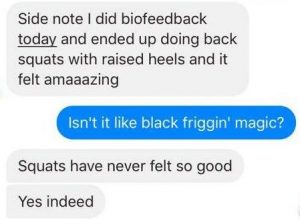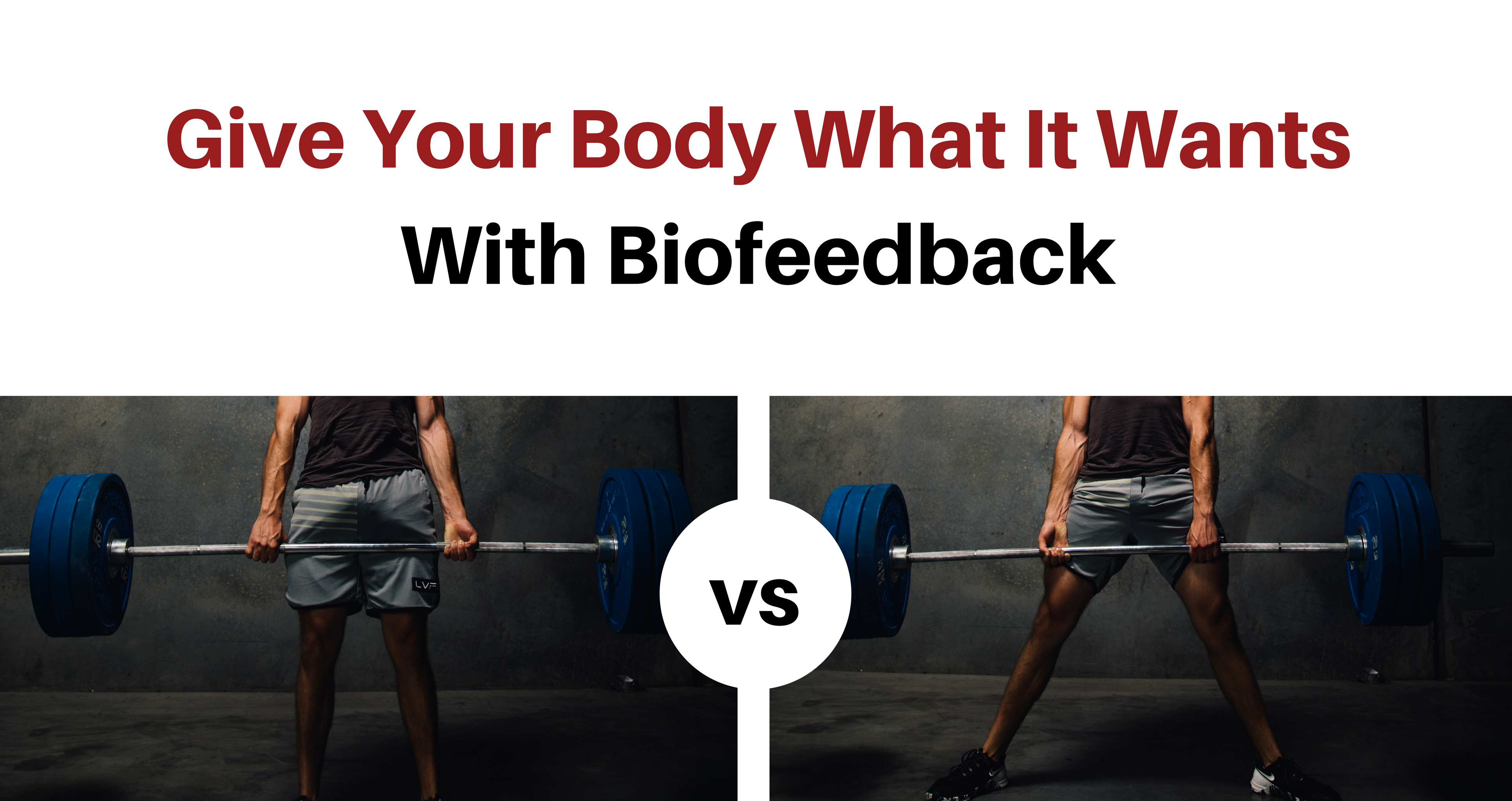Remember that song Bump and Grind by R. Kelly? It’s a classic. And even if you aren’t familiar with the song itself, I bet you’ll recognize the first line: “My mind’s telling me no. But my body… my body’s telling me yes.” It’s an iconic lyric. But listening to your body is actually great advice.
When it comes to fitness, you’re stifling progress if you’re not listening to your body
 Basically, you need to be like R. Kelly. When your body’s telling you yes, you should listen. When you’re body’s telling you no, you need to listen. You’ll look, feel, and lift so much better.
Basically, you need to be like R. Kelly. When your body’s telling you yes, you should listen. When you’re body’s telling you no, you need to listen. You’ll look, feel, and lift so much better.
All you need is the right conversation with your body. Below, I’ll show you exactly how to have it. It’s incredibly simple. It’s also one of the quickest ways I know to improve performance and progress.
The conversation’s already happening. Your body talks to you all the time. The problem is you’re not listening.
Most of us are terrible at hearing what our bodies say. Until it starts screaming with a pulled hammy, kinked neck, or hurt elbow, we don’t hear a thing. Usually, you only start listening to your body when it’s already too late. The damage is done.
Lucky for you, there’s a better way—a simpler, less painful way.
When you have the right conversation with your body, you’ll get immediate feedback. When you’re listening to your body, you’ll start working with it instead of against it. And when you’re working with your body, you’ll get better results—instantly.
The key? Biofeedback testing, your step-by-step strategy to start listening to your body and improving performance.
No Pain, No Gain Is Asinine—Start Listening to Your Body
Ever do a workout that completely destroys you? One that leaves you hobbling around the rest of the week? A workout that annihilates muscles you didn’t even know existed? And a workout that’s more pain than perspiration?
Well, you should stop. These aren’t good things.
You want workouts to build you up, not beat you down. It should be challenging, difficult, tiring—all that jazz. But you should leave feeling great, not gross.
A workout doesn’t have to make you feel like death to be effective.
Most say, “No pain, no gain.” I say we ditch the pain and keep making gains. Or shedding fat. Or fitting into our favorite pair of jeans again. Or whatever else you’re trying to do with fitness.
There’s an important difference between pain and fatigue.
Feeling the burn at the end of a set isn’t pain. That’s fatigue. It might be uncomfortable, but that’s okay. Your body’s doing exactly what it’s supposed to do and functioning properly. #lacticacid

A sharp pinch in your back or a nasty click in your shoulder? That’s another story. That is pain. That’s dysfunction.
At that point, you need to start listening to your body before it’s too late.
Pain Isn’t Indicative of Results, It’s Indicative of Injury
When something hurts, stop.
That’s not what most people do. And odds are that’s not what you do either. Instead of listening to your body, you push through the pain. Because, you know, “no pain, no gain.”
It’s asinine.
In the world of fitness, consistency is king. Keep consistent with a solid program and you’ll inevitably get great results. One sure-fire way to ruin that is with nagging injuries.
Injury-induced inconsistency will cripple your progress.
Pain and gain are inversely correlated. The more pain you feel, the less gain you’ll see. Less pain? More gain.
Going hard in the gym is great, but not when it lands you hurt and out of commission. The simplest way to avoid that is to start working with your body instead of against it. When you start truly listening to your body, it starts hurting less and performing better.
Biofeedback testing will help you do exactly that—feel less pain and get better results.

I received this message about biofeedback from a member of my coaching program just a few days ago. Basically, it’s magical.
Listening to Your Body With Biofeedback Testing
Biofeedback isn’t a new idea. It’s something that’s used regularly in medicine and therapy. In fact, you’ve probably even used biofeedback. Put simply, it’s using some sort of tool to collect information (feedback) from your body (bio).
If you’ve every used anything like a heart-rate monitor or thermometer, you’ve used a simple form of biofeedback testing. Like I said, the concept isn’t anything new.
But using biofeedback in an exercise program? That is a new idea.
It’s also an incredibly simple and effective way to start listening to your body, minimize aches and pains, and maximize your results.

Here’s what biofeedback looks like in the gym.
1. Establish your baseline with an initial test.
2. Test a few different exercises or variations.
3. Compare the results of each test.
4. Do whichever exercise or variation tested best.
This is listening to your body.
By testing different exercises or variations against the baseline with biofeedback, you’ll see how your body responds to each specific stimulus in real time.
Worse than baseline? It’ll be best to avoid that one. Better than baseline? Awesome. Tested best? That’s what we’re looking for, do that exercise or variation.
Biofeedback opens up the conversation with your body. When you learn to listen, your body will tell you what it wants.
If your body responds well—if it’s telling you yes—you should be like R. Kelly and listen. If your body doesn’t respond well—if it’s telling you no—you need to listen.
How to Use Biofeedback, Start Listening to Your Body, and Perform Better Today
The first thing you need to collect biofeedback is a tool for testing. In the gym, range of motion (ROM) testing is that tool. Increases in ROM are positive tests (testing well) and decreases are negative tests (not testing well).
Personally, I like the toe touch. For most people, it’s a simple, familiar test that gives clear results.
Establishing Your Baseline
To establish your baseline with a toe-touch test, bring your feet together, keep your legs straight, and do a toe touch. But don’t stretch down as far as possible.
Only go down until you start to feel tension or tightness in your hamstrings, glutes, low-back, big toe, or anywhere else.
The goal is to collect information, not to stretch. When you start to feel tension, briefly pause and make a mental note of your ROM. (I’ve even held lifting chalk in my hand to make literal marks on my shins, but mental notes work too.) And then come right back up.
To establish your baseline:
– Do a toe touch.
– Only go until you start to feel tension or tightness.
– Take note of your range of motion.
– Stand back up.
Boom. Just like that, you’ve got your baseline.
Test Variations
Once you have a baseline, you’re ready to test different exercises and variations. You can test both macro-variations and micro-variations. Macro-variations test things like front squats against back squats or conventional deadlifts against sumo deadlifts. Micro-variations test things like a wide grip against a narrow grip or a staggered stance against even foot placement.
First, test the macro-variations and exercises. After you’ve found which macro-variation tests best, move on to micro-variations within that exercise.
There’s virtually no end to the number of things you could test. But I only recommend testing a handful of macro and micro-variations. Usually, that’s more than enough to find something that’s testing well.
Before performing your toe touch for the variations, you’ll do three pseudo-reps of whatever exercise or variation you want to test. A pseudo-rep should be done with little to no weight.
If you’re not using any weight, pretend it’s there. Seriously. Set up as if a bar was in the racked position if you’re testing front squats or reach down to an imaginary bar if you’re testing deadlifts. Make the test reps as real as possible.
After your three reps, do your toe touch. Then rinse and repeat for each exercise or variation you’re testing.
To test your variations:
– Perform three pseudo-reps.
– Do another toe touch, again only going down until you feel tension.
– Take note of your range of motion.
– Stand back up.
– Move on to the next one.
Compare Results
As you do your biofeedback testing, compare the results to find what’s testing best. How do you know? Simple. Whichever exercise or variation had the best range of motion, tested best. If your body responds well to a movement, it’ll proverbially tell you so with increased ROM.
Here’s what biofeedback might look like on a deadlift day:
Baseline test (let’s say you got ~3/4 of the way down your shin).
You test three macro-variations: conventional, trap-bar, and sumo deadlifts.
After your pseudo-reps and tests, you compare the biofeedback. Sumo deadlifts test poorly—nly to the middle of your shin, worse than baseline. Trap-bar tests well—down to your shoes, better than baseline. And conventional tests best—all the way down to your toes.
You’ll do conventional deadlifts today.

If you decide to test micro-variations, you could test foot placement: both feet forward, left foot slightly turned out, and right foot slightly turned out.
After your pseudo-reps and tests, you find that both feet forward tested best. Awesome.
Your body wants you to do conventional deadlifts with toes forward. Listen to your body.
Do What Tests Best to Start Listening to Your Body
When I learned about biofeedback, I honestly thought it sounded weird—a strange woo-woo tactic that might have a nice placebo effect.
I figured the changes in range of motion tests were simply the result of loosening up from the previous tests. And I didn’t see how such small tweaks could make such a big difference. I was terribly mistaken.
When I shelved my doubts and skepticism to give it a try, I was blown away.
I used biofeedback testing with each of my main lifts that week. The results? I set new personal records in every single one. Literally a new PR with every lift that I tested. Just like that, I was a believer.
If you want to maximize your results, you need to have the right kind conversation with your body. It’ll tell you exactly what it wants if you know how to ask. Biofeedback testing is how you’ll ask the right questions.
Then, take a page out of R. Kelly’s book and listen to what your body’s telling you. When you start listening to your body, you’ll feel better, you’ll lift better, and you’ll see better results.
Use biofeedback testing today. Feel amazing.




